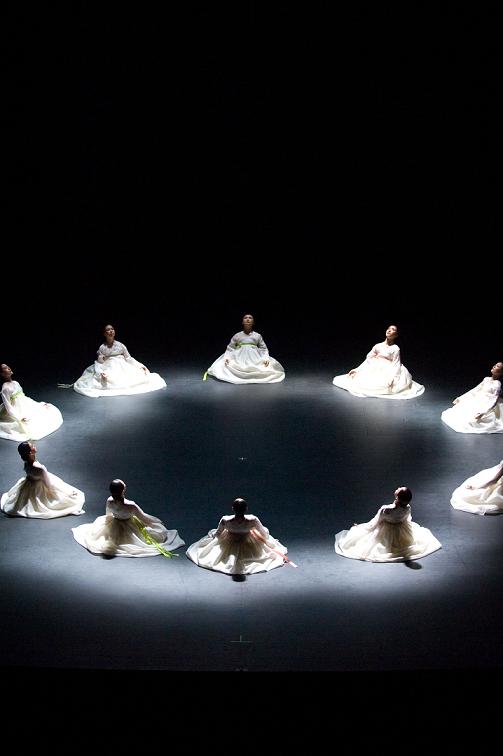
Myung Sook Kim Nulhui Dance Company’s performances have always been a motivation to the audiences. At her Hague performance, a foreigner was so touched to shed tears after the concert; sold out seats were nothing compared to the standing ovations from the audiences after the performance. This September 9, the dance company is ready to present an even greater sensation to the audience at the Seoul Arts Center. This performance titled “Four Seasons drawing with Dance (Sang Sang Two)” is a masterpiece where the dancers practiced five hours every day starting from June 1 in order to drag out the most delicate and exact movements. Following 70 minute long kayagŭm (a Korean 12-stringed long board zither) piece by Hwang Byung-ki, the composer, music director as well as a Professor Emeritus at Ewha, the performers will illustrate Korea’s four intrinsic and distinctive seasons.
Founded by Professor Kim Myung-sook (Dance), the art director of Nulhui Dance Company, in 1996, Myung Sook Kim Nulhui Dance Company has been the forefront players in promoting the Korean traditional dance. Without an intermission, 12 dancers, who symbolizes the 12 months of a year, will dance along Professor Hwang’s 70 minute long piece as well as cinematic video clips produced by Choi Yoo-mi (Visual Communication Design) being showed.
I. Spring
Kim, the art director, tried to portray spring as the season of growth which is portrayed by process of the blossoming maehwa (also known as Chinese plum or the Japanese apricot or ume flowers). For 20 minutes, the dancers who first start lying down on the stage will slowly rise and convey a very detailed process of a blossoming maehwa.
“This slow yet delicate move requires a great amount of energy and physical strength,” said Kim. “In order to do so, we carried out an hour of warming up session everyday to make our dancers’ body fit.”
II. Summer
Kim will be participating in this act specially to portray the coolness and the peacefulness of the bamboo forest. A video clip which will illustrate several images of bamboo forests will dissolve the audiences, making them feel as if they are actually in it themselves.
“Audiences will be awed to see the images displayed at the show which are unbelievably beautiful and grandiose natural scenes in Korea,” said Kim.
III. Fall
The most romantic season is highlighted with a faster music which goes hand in hand with the quick process of autumn leaves fading and falling. The rich color of this season has been featured in their costumes which were exclusively designed by Kim Jung-hee(’97, Department of Clothing & Textiles) a professor at Kyungwon University.
The costumes that are worn in this performance are all hanbok (traditional Korean dress) with a little bit of a modern taste added. Kim expressed her excitement towards the costumes describing them “so hip yet traditional it could probably end up in a runway any day soon.”
IV. Winter
When the performance reaches its climax with the rapid music beat, everything suddenly stops. There is silence and absolutely no movement. The atmosphere becomes tense and serene. Slowly and gently, like the snow melting, the dancers will quietly fade away into the darkness.
Kim Myung-sook has been the frontier in promoting Korean traditional dance worldwide as a Mecca of Korean culture. Kim says, this piece which highlights the distinct four seasons/features of Korea was inspired by years of traveling around the motherland. She took an eight hour drive up and down the South Korean peninsula to come up with a choreography that would perfectly fit a 70 minute kayagŭm melody. She “wishes her performance could possibly move the hearts of the audiences expecting another round of a standing ovation.”
This performance is also invited by the Asia Society, America's leading institution dedicated to educating Americans about Asia, to be performed in Manhattan this October.
“I hope the efforts we poured into this masterpiece would flourish and change the perspectives of Korean culture,” said Kim. 

